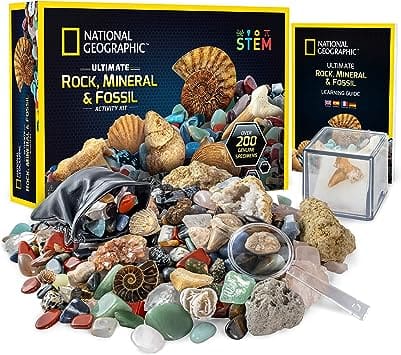NATIONAL GEOGRAPHIC Rocks & Fossils Kit

As we explore the magic of minerals in our journey into mineralogy, it’s important to get hands-on experience. What better way to do that than with the National Geographic Rocks & Fossils Kit?
This 200+ piece set is an absolute treasure trove for budding mineralogists. It’s not just a kit, but an adventure packed in a box. From geodes to real fossils, from rose quartz to jasper, from aventurine to many more rocks, crystals, and gems, this kit provides an array of specimens to examine and learn from.
200+ Piece Set Includes Geodes, Real Fossils, Rose Quartz, Jasper, Aventurine & Many More Rocks, Crystals & Gems
The kit even includes a full-colour learning guide to help identify each rock, gemstone, mineral, and fossil in the collection, making it a perfect companion for our dive into mineralogy. You can crack open real geodes to discover crystal treasures, examine genuine fossils, and display your favorite specimens in the included case!
The National Geographic Rocks & Fossils Kit is not just an educational tool, but a journey to the heart of our planet. It’s a great gift for kids and adults alike who are interested in geology and mineralogy. So why wait? Join us in this amazing journey of discovery and dive deep into the world of minerals with the National Geographic Rocks & Fossils Kit.
Start your mineralogy adventure today. Explore, learn, and discover with National Geographic. Because the earth does not just belong to us, we belong to the earth.
Introduction
Mineralogy, the detailed study of minerals, is a fascinating field that intersects science, nature, and even art. It’s a world filled with dazzling crystals, glowing gemstones, and metals that have built our civilization. One of the key tools in the study of minerals is crystallography. This blog post will delve into the magic of minerals, highlighting the importance of mineralogy and the pivotal role crystallography plays in understanding these natural wonders.
The Science of Mineralogy
Mineralogy is the scientific study of minerals, which are naturally occurring substances with a definite chemical composition and crystalline structure. There are over 5,000 known types of minerals, each classified based on their physical properties and chemical composition. These classifications are instrumental in various scientific and industrial applications.
The Role of Crystallography in Mineralogy
Crystallography, the study of crystal structures, is a vital tool in mineralogy. By analyzing the atomic arrangement in a mineral, crystallography allows scientists to identify different types of minerals, understand their properties, and predict how they’ll behave under different conditions. Crystallography can reveal the hidden substructures in a mineral that influence its color, hardness, and other properties.
The Benefits of Understanding Minerals
Understanding minerals is crucial in diverse fields. In geology, minerals help us understand the Earth’s history and processes like plate tectonics. In materials science, minerals inspire the design of new materials. For instance, the iridescent shine of opals has inspired photonic designs, and the strength of diamonds has led to ultra-hard materials. Even in the realm of jewelry, understanding a gemstone’s mineral properties can aid in its identification, cutting, and care.
Moreover, studying minerals can solve various problems. For instance, by understanding a mineral’s resistance to heat or pressure, we can design better equipment and structures for harsh environments. Or by understanding how minerals react with the environment, we can predict and mitigate the environmental impact of mining.
Practical Examples
Crystallography has been instrumental in understanding and identifying minerals. For example, the discovery of quasicrystals was made possible by crystallographic studies. These strange materials have a regular pattern that never repeats, a property once thought impossible.
Crystallography has also been used to discover new minerals. For instance, the mineral “bridgmanite,” the most abundant mineral in the Earth’s lower mantle, was identified through its unique crystal structure.
Recommended Resources for Further Reading
To dive deeper into the world of minerals and crystallography, consider these books available on Amazon: “Introduction to Mineralogy and Petrology” offers a comprehensive overview of the subject, while “Crystallography and Crystal Defects” delves into the intricacies of crystal structures.
Conclusion
The world of minerals is a beautiful and complex one, filled with structures and properties that continue to surprise and intrigue us. By understanding minerals and their crystal structures, we not only appreciate their beauty but also unlock their potential in solving real-world problems. So, why not embark on a journey into the magical world of mineralogy and discover the incredible world beneath our feet?
Check out our Glossary for more interesting terms
Other Articles
Thank you for exploring ‘The Magic of Minerals: A Dive into Mineralogy’. We hope this article has provided the information you sought. If you found it valuable, please consider sharing it. For further reading, you might be interested in these other articles on sunnydaysgo.com:
- Unfolding Earth’s Past: A Deep Dive into Fossils
- The Role of Paleontology in Understanding Earth’s History
- Elk Island National Park: A Breathtaking Wildlife Haven
- Story About Eddie The Elk – Elk Island
- Heat and Its Role in Climate Change: A Deep Dive
- How to Prepare for Extreme Weather Events
